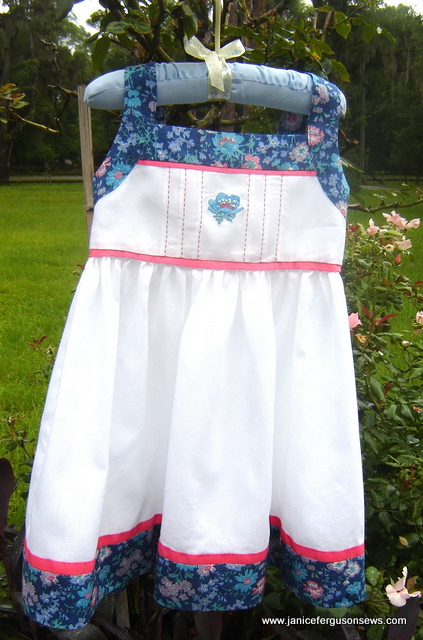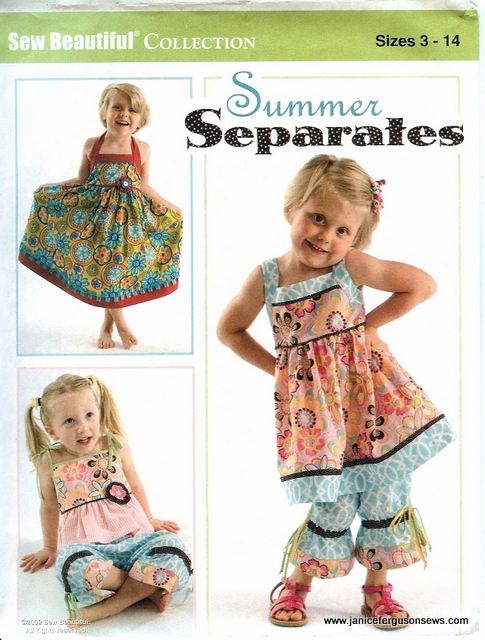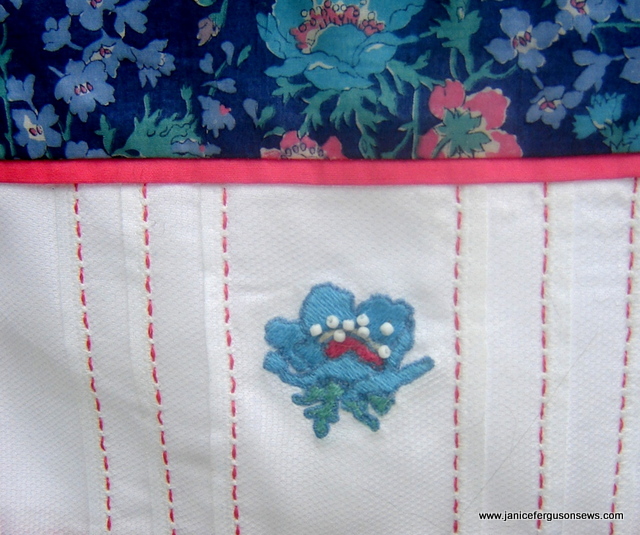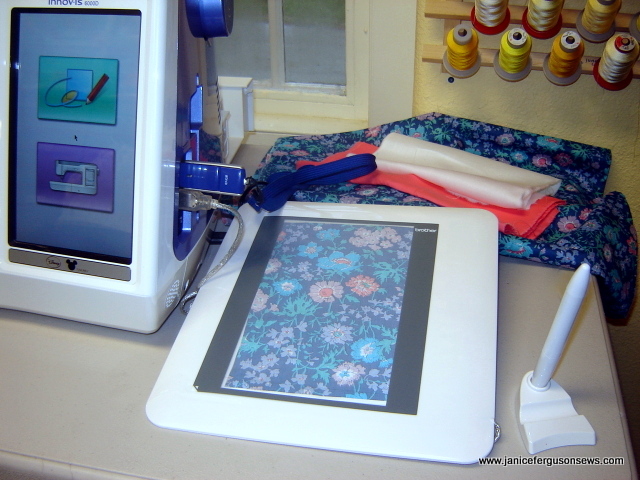The past two weeks have been very, very hectic. Aside from an increase in the busy-ness of everyday life, I’ve been learning more about my Brother Quattro sewing/embroidery comb machine. This little sundress is the result of my first attempts at using a few of the amazing features. I’m just blown away with the impact of technology on today’s sewing machines.
Somewhere, I have a booklet printed in 1900 which celebrates the advances in Singer sewing machines up to 1900. In that little publication, it was stated that every advance possible had been included in the newest Singer sewing machine model. Again and again, it stressed that there were absolutely no more improvements possible! The machine stitched forward and backward and stitch length that could be adjusted. What more could sewing women want? The machine of 1900 was perfected.
They were wrong.
But first, here are the specs on the dress. The pattern is Martha Pullen’s Summer Separates.  Now that my granddaughter, Laurel, is 8, I am happy to have a pattern that reaches up into the big girl sizes.
The fabrics are white Swiss pique, Liberty of London tanna lawn print, and pink pima cotton for trim. The pearl buttons (4 in the package) were purchased years ago at an antique mall and are a near perfect match to the pink pima. Hurrah!
There are three 1/4″ pin stitched tucks on either side of center.  Four strands of twisted cord are woven through the pin stitch holes.
Like the front and back yokes, the hemline band of Liberty is trimmed with a foldedstrip of pink pima cotton. I tried to pinstitch the trim piece, but even with a 100 sharp, there was too much bulk with two layers of starched pima broadcloth and one layer of pique. So the trim is held in place with a little blanket style stitch.
Now, on to the technology. See the embroidered flower on the bodice? That is a pretty close copy of the flower in the Liberty print used to border the yoke, armscyes and hem.
So what’s the big deal about that? Digitizing programs have been around for many years now. Right?
Well, yes.  But the learning curve for that application was a little too steep for techno-challenged Janice and others like me. I’ve always simply edited existing designs with BuzzEdit2, though it sometimes takes me hours to find one suitable for tweaking.  But there are no designs exactly like the flower in the Liberty print.
Pen tablet to the rescue! With this little marvel, design creation is easy peasy. You simply slip a drawing or photo or whatever under the clear flap and trace it! You have options–size and color of outline, color and direction of fill stitches, size of design. Maybe more. But that was enough for me.
I simply scanned the fabric, printed the image, slipped it into the pen tablet, selected a flower to copy and traced it. Bam! The flower was saved in my machine memory stick or thumb drive ready to be embroidered! Pure magic.
Now I’m thinking about special pictures that my children (long, long ago) and grandchildren have drawn and how I now can capture them in thread. There is no limit to the things that can be copied and stitched, but I especially love the ability to take an image from a print fabric. Moving on…..
Next, I explored the machine’s edge stitching capability. This was put to the test making the tucks. I’ve always used the edge stitch foot for tucks, but the maximum width of the tuck is dictated by the distance from the “wall” on the foot and sometimes I want a wider one.
You simply place a special sticky sheet over the throat place and attach a special foot. Set the desired width from edge to sewing, such as 1/4″ seam allowance used by quilters, and turn it loose! Check out this short video. You have to scroll down the page until you come to “The Perfect Seam Allowance.” The scanner on the sewing machine reads the texture printed sheet and then, via its computer, compares it to the image with your fabric in place. It maintains the seam allowance regardless of curves or irregularities in the fabric edge. How handy is that???
Brother describes this feature. “Edge sewing is so simple. InnovEyeâ„¢ follows the edge and—guided by a pre-set seam allowance—keeps stitches smoothly hugging the edge whether they are straight or curved. Sew a long, thin piece of material, like a ribbon, with ease.
After all six perfect tucks were finished, I went back and pin stitched over the seam line. Because I used 80 wt. thread for the first pass, those threads were nearly invisible as they melted into the pique so there was no need to remove them.
Finally, a 4 strands of cotton sewing thread were twisted into cord with the bobbin winder and then woven through the pin stitch holes.
Technology never ceases to amaze me, but now, as Will sang in the movie Oklahoma, http://www.youtube.com/watch?v=cjt6McMb5eE. “Whats next? They’ve gone about as fer as they can go!”
What more can our sewing machines possibly do? Are you wonder struck by the capabilities of your sewing machine? How does it compare to the one on which you learned to sew? What features do you like best about your machine?






7 responses to “New Sundress, NewTechniques”